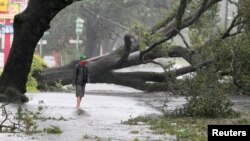WASHINGTON —
If history is any guide, a new study predicts the intensity of hurricanes along the southeastern coast of the United States may increase because of rising global temperatures. Climatologists also expect that storm activity in the western Pacific will be greatly affected by global warming during this century.
Analyzing data from 1923 to the present, the statistical model by an international team of researchers predicts there may be a dramatic rise - anywhere from a two- to seven-fold increase - in the number of Katrina-magnitude hurricanes along the Atlantic coast of the United States. Katrina, a Category 5 storm, devastated New Orleans, Louisiana, in August of 2005. The study was published in Proceedings of the National Academy of Sciences.
Tom Knutson, a research meteorologist with the National Oceanic and Atmospheric Administration at Princeton University in New Jersey and a specialist on extreme climate events, uses a computer model to simulate hurricanes, allowing him to alter climactic conditions to predict storm intensity.
"What our model suggests is that [if] you have a global warming due to increased greenhouse gases; you have warmer sea surface temperatures. You also have a lot of warming in the atmosphere above the ocean. And these effects operate to gather stronger hurricanes in the warmer climate," he said.
Knutson says his modeling predicts fewer but more intense hurricanes, with a 40 to 80 percent increase in the strongest Atlantic storms in the 21st century.
Similarly in the western Pacific, Knutson says there has been a decrease in the number of tropical cyclones, but the ones that have occurred have brought stronger gusts and more precipitation.
According to the Joint Typhoon Warning Center in Hawaii, there were just 19 named tropical storms in 2010, well below the historical average of 31 typhoons.
"We were actually a little bit surprised to find this when we studied our climate simulations and even trying to figure out why we’re getting a decrease in the models is actually a difficult research problem which we are struggling with," said Knutson.
But, despite an increase in the intensity of storm activity around the world, Knutson says climatologists still cannot definitively point to human activity as the culprit.
Analyzing data from 1923 to the present, the statistical model by an international team of researchers predicts there may be a dramatic rise - anywhere from a two- to seven-fold increase - in the number of Katrina-magnitude hurricanes along the Atlantic coast of the United States. Katrina, a Category 5 storm, devastated New Orleans, Louisiana, in August of 2005. The study was published in Proceedings of the National Academy of Sciences.
Tom Knutson, a research meteorologist with the National Oceanic and Atmospheric Administration at Princeton University in New Jersey and a specialist on extreme climate events, uses a computer model to simulate hurricanes, allowing him to alter climactic conditions to predict storm intensity.
"What our model suggests is that [if] you have a global warming due to increased greenhouse gases; you have warmer sea surface temperatures. You also have a lot of warming in the atmosphere above the ocean. And these effects operate to gather stronger hurricanes in the warmer climate," he said.
Knutson says his modeling predicts fewer but more intense hurricanes, with a 40 to 80 percent increase in the strongest Atlantic storms in the 21st century.
Similarly in the western Pacific, Knutson says there has been a decrease in the number of tropical cyclones, but the ones that have occurred have brought stronger gusts and more precipitation.
According to the Joint Typhoon Warning Center in Hawaii, there were just 19 named tropical storms in 2010, well below the historical average of 31 typhoons.
"We were actually a little bit surprised to find this when we studied our climate simulations and even trying to figure out why we’re getting a decrease in the models is actually a difficult research problem which we are struggling with," said Knutson.
But, despite an increase in the intensity of storm activity around the world, Knutson says climatologists still cannot definitively point to human activity as the culprit.






